Spherical thuja: description, types and cultivation
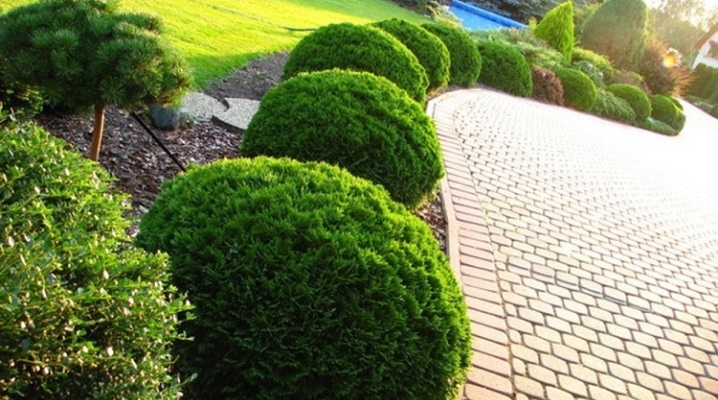
Among the many ornamental plants, spherical thuja is especially loved not only by professional designers, but also by amateur gardeners. It can often be seen in compositions that adorn public gardens and city parks, and in garden plots.



Description
Thuja belongs to the cypress family of the genus of evergreen gymnosperms conifers. Thuja is native to North America and East Asia, where it grows in the wild. Thuja is a shrub, less often a tree, reaching 70 m in height with a needles diameter of 2.5 m. Young thuja has soft needle-shaped leaves, and an adult plant is opposite, criss-cross, scaly leaves.
After flowering, oval or elongated cones are formed, covered with scales. Flat seeds, which ripen in autumn, have 2 narrow wings. Its genus includes 5 species: western and Korean thuja, Japanese and Sichuan, giant (folded) thuja.
Each of these species has a huge number of varieties obtained as a result of breeding and is classified according to 2 parameters:
- on application in landscape design;
- in the shape of the crown.
According to the form, varieties of thuja are distinguished:
- pyramidal;
- columnar;
- kegle-shaped;
- umbrella-shaped;
- spherical.

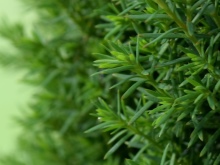
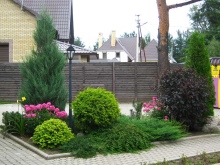
Thuja globular is not a special separate type of plant, but the result of selection. Round-shaped bushes have different types of thuja (Korean, Western, Japanese and other types). In our country, it is possible to grow only the western globular thuja. Unlike other species, it tolerates Russian climatic conditions well and has a wide variety of varieties.
Western thuja with a round crown is a frost-resistant evergreen long-lived shrub: it can grow for 50-150 years. This is a short shrub, in which branches grow in such a way that they form a ball or cone with a dense crown. Some varieties do not even need corrective pruning, as the round shape forms on its own.
Globular thuja is a dwarf variety and its development is characterized by slow growth. For 100-150 years, it can reach only 1-2 m, and the highest height can be 2.5 m. Usually, its minimum height does not exceed 0.5 m and often is only a few tens of centimeters. The branches are covered with a smooth brown bark with a reddish tint. Its needles grow for about 3 years and can reach a length of 7 cm, after which they fall off along with small branches. The needles of young bushes are soft, but as the plant grows, it becomes coarser.
Flowering occurs in spring, then small (about 1.2 cm) oval or elongated scaly cones are formed, containing 2 seeds. The crown can have different shades: from dark green to yellow-green, from brown and brown to golden. Thuja retains the rich color of its needles all year round. Therefore, these decorative qualities of it make it possible to emphasize other flowering plants in summer, and in autumn it is the main and dominant element of the decor. Western spherical thuja tolerates well the polluted air of the city.
It contains and enriches the atmosphere with essential oils and substances that inhibit the growth of microbes. Therefore, the air around the thuja plantations is clean and has a specific aroma.
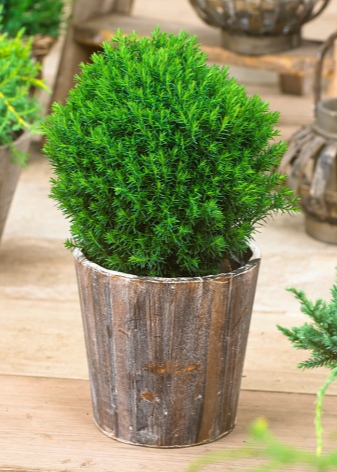
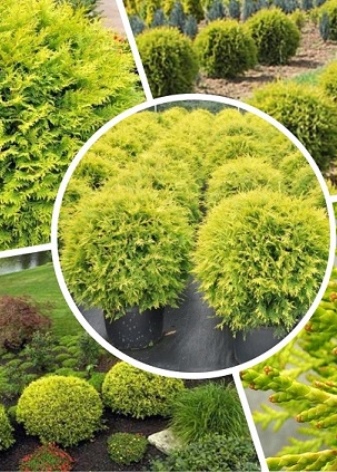
Popular types
Varietal types of thuja with a spherical crown are represented by a wide variety. Such varieties have gained the greatest distribution and popularity.
- "Globoza". This is the very first variety of spherical thuja obtained in the middle of the 19th century. It is distinguished by a rather high growth: an adult thuja can grow up to 1.5-2.5 m. Compared to other varieties, it is fast-growing: in 1 year it can grow by 10-20 cm. In the first years of growth, the bushes do not yet have a main trunk. The leading shoot can form only in 10-15 years. At the beginning, the crown acquires a narrow triangular shape, which becomes round only for 5-7 years. The upward-facing needles have a tendency to change their color in accordance with the season: in the summer they have a rich green color, which turns gray by winter. The density and density of the crown increases with the growth of the plant. Globoza does not require formative pruning.

- Danica. This variety was obtained by breeders in Denmark in the middle of the twentieth century, it belongs to the undersized variety. Danica is notable for its slow growth. The plant grows in 1 year about 5 cm in height and about 4 cm in width. A ten-year-old bush can reach a height of half a meter and about 1 m in diameter, and the maximum height can be 0.8 m. It is characterized by unpretentiousness to conditions, grows well both in illuminated and shady areas. However, in the sun, the color of the needles of the bush becomes more saturated, and the crown becomes thicker. Danica has good frost resistance. The variety does not require formative pruning.

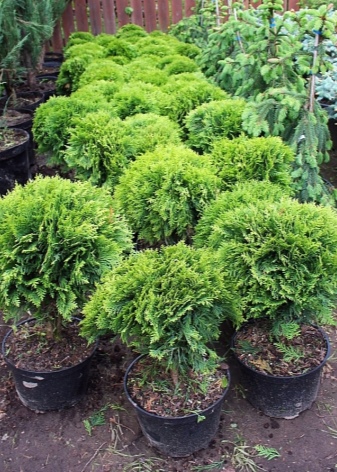
- Thuja "Reingold" refers to a tall variety of round thuja, the height of which can be 1.5 m. The variety is characterized by the ability to change the color of the needles: in spring it has a pink hue, which turns golden in summer, and in autumn it becomes yellow-copper, almost brown. At first, young bushes with thin branches have a spherical shape, which becomes oval as the plant grows and matures.
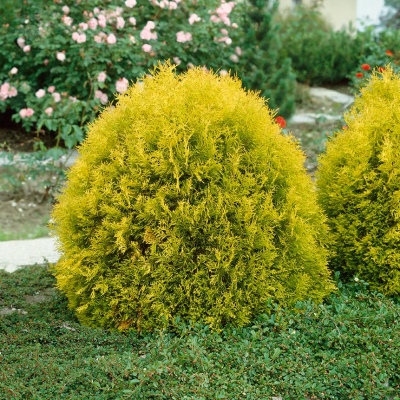
- Dwarf round thuja "Teddy" is a newly developed, slow growing variety. The crown of this small bush, which grows up to only 30 cm in 10 years, is distinguished by its extraordinary density and accuracy. "Teddy" has smooth, thornless, deep green needles. In winter, it becomes brown, and the bush itself takes the form of a pillow. The variety tolerates the lack of sunlight well, for normal growth it only needs a few hours of exposure to the sun.
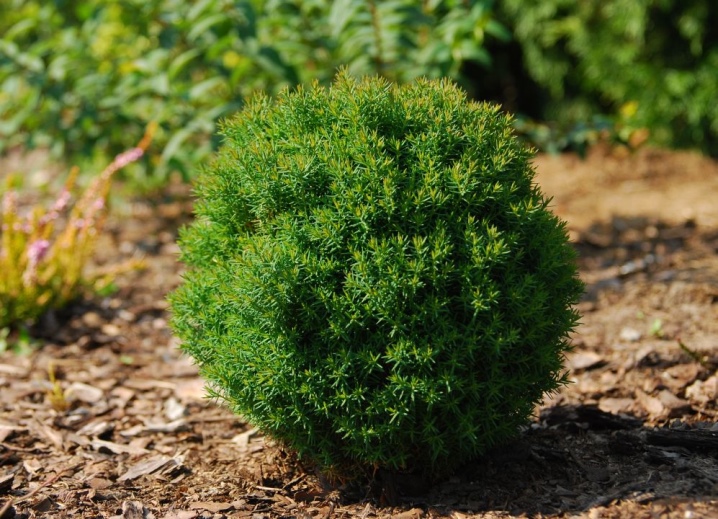
- Variety "Tini Tim" is a representative of dwarf thujas. This is a fairly well-known and old variety, bred more than half a century ago. The height of the plant by the age of 10 can reach only 0.3 m, and the width - 0.5 m. Small thuja is characterized by slow growth, adding only 2 cm in height annually. The dark green color of the needles is distinguished by its saturation and brightness. The variety tolerates drought well, is resistant to cold weather, but prefers the sun: in the shade, the crown becomes loose.

- Golden Tuffet - a small bush with a height of about 35 cm, which has spectacular beautifully flowing branches that form a lace frame. The needles are colored orange in winter and golden in summer. The variety prefers sunlight: in the shade, the color of the needles becomes dull.



- Thuja varieties "Golden Glob" is also a fast growing variety. Its annual growth is about 10 cm. The low bushes are covered with needles that change their color: in the spring it is golden, in the summer there is a green tint, and in the fall it is copper. The plant has a neat and dense crown that does not require pruning. Poorly tolerates drought and likes shady areas. Has a high frost resistance.
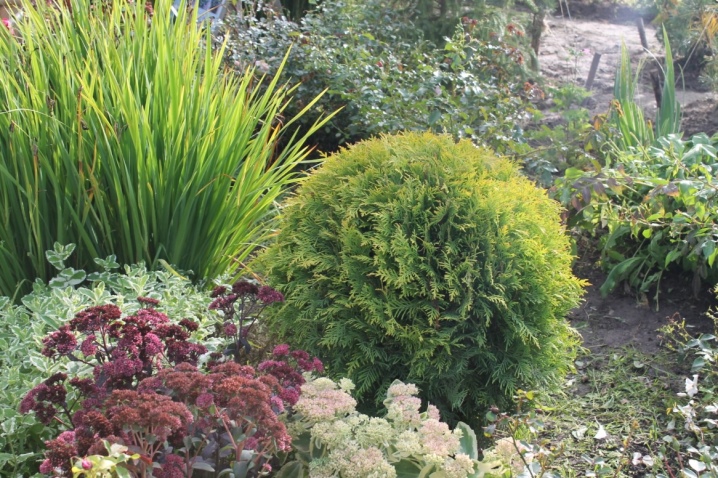
Western spherical thuja varieties can differ in appearance and in their requirements for growing conditions.However, a common property for all varieties is their frost resistance: "Danica" survives frosts down to -40, and "Teddy" - even up to -45 degrees.
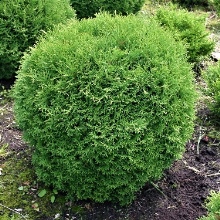
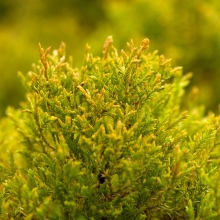

How to plant?
Before planting a thuja in open ground, it is necessary to correctly determine the place of its landing. The choice of location is often influenced by the variety of spherical thuja. Plants with yellow or light needles require abundant lighting, while thuja with dark needles prefer shaded areas.
But basically, these plants love areas that are sunny, but inaccessible to direct sunlight. The best place in the garden is partial shade, so that in the daytime the sun is replaced by a shadow. In bushes constantly growing in the shade, the crown becomes sparse, the branches stretch out and the plant loses its decorative appearance. Among other things, the landing site should not be accessible to the winds, since the plant does not tolerate drafts.
Although thuja is undemanding to the composition of the soil, it grows better on moderately moist fertile soil. You should also avoid areas where groundwater is shallow from the surface.
In low-lying areas, when landing in a landing hole, it is necessary to place a drainage with a layer of about 20 cm.
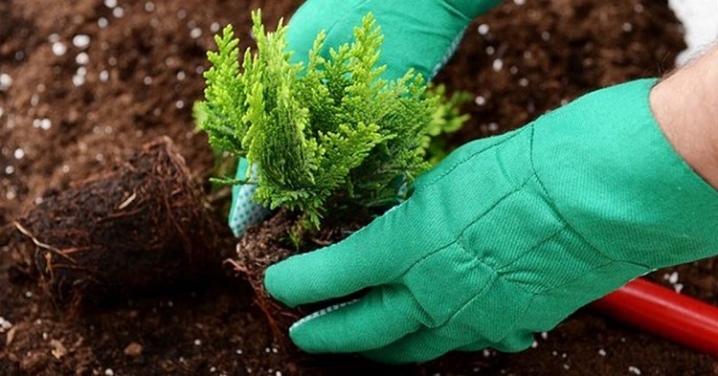
The best planting time is considered early spring before the onset of active vegetation of the plant. Over the summer and autumn, the bushes will take root well and prepare for winter. Transplanting seedlings is also possible in the fall. The best seedlings for transplanting are 3-5-year-old bushes. Landing pits are prepared in advance, about 14 days in advance, so that the soil is saturated with oxygen. A special nutrient mixture is placed in them, consisting of 1 part of peat, 1 part of sand and 2 parts of sod soil. For varieties requiring nutritious soil, you can add fertilizer (nitroammofosku).
When planting a seedling, you must follow the rule: the root collar should be above the ground level, so the planting hole should not be very deep, but spacious enough to conveniently place the plant's root system in it. Before transplanting, the soil in the container is abundantly moistened, then the seedling is gradually released and placed in a prepared pit. It is also necessary to fill up the soil gradually, pressing it down slightly to avoid voids. Then, a hole is formed near the planted bush so that water does not flow out during watering.
For group plantings, the distance between the planting pits should not be less than 50 cm. In this case, one must also take into account the dimensions that an adult plant will have. For example, for varieties "Globoza" and "Golden Globa" the gap between the bushes should be from 2 to 3 m.
For the entire first year of growth, young bushes must be protected from direct sunlight, since they do not tolerate it well. To do this, the bushes need to be shaded and covered with any fabric or covering material.

Correct care
It is not difficult to care for thuja, you should only carry out the usual activities: watering and loosening the soil, applying dressings, pruning bushes and preparing for wintering. Immediately after transplanting, the plant requires daily watering for one month. One bucket of water is poured under each seedling. In the future, watering is reduced to once every 7 days, the amount of water is the same - 10 liters per plant. An adult thuja is also watered.
In drought and very hot weather, you need to water the thuja more often - about 2 times every 7 days. For varieties that require more abundant watering, in addition to moistening the soil under the bush, it is recommended to do water spraying of the crown. Watering should be accompanied by loosening the earth under the bushes. This is necessary in order to provide air access to the roots of the plant. The depth of loosening should be about 10 cm. Then the soil near the bush is covered with mulch (peat, sawdust, compost), the thickness of which should be 7-10 cm. It will keep moisture in the soil, and will also prevent the growth of weeds.
It is not necessary to fertilize thuja for 3-4 years after planting, since the plant has slow growth.Then top dressing is applied as needed, approximately every 2 or 3 years, using complex mineral fertilizers. In the spring, you can feed the thuja with Kemira Universal (50-60 g per 1 sq. M) or nitroammophos (30 g per 1 sq. M). Organic fertilizers can also be applied in spring. In autumn (October) potash fertilizers are usually used.
The required amount of fertilizer is directly affected by the spherical thuja variety: dwarf varieties need less fertilizer than tall ones.
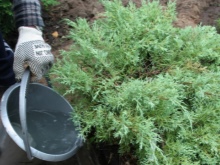
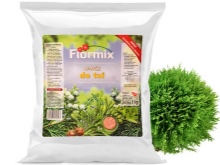

Many varieties of spherical western thuja do not need pruning: the round shape is formed naturally. However, in the spring, it is necessary to carry out a sanitary shearing of the plant: dried, diseased and damaged shoots are removed. Thuja, which is used as a hedge, needs to be trimmed 2 times - in the spring and at the end of August, in order to maintain the height of the plantings. The dense crown of bushes allows for decorative shaping. Specialists-designers can give the bushes any shape to decorate the landscape.
Corrective pruning consists of cutting off branches that are in the wrong direction of growth. They also remove unnecessary branches that prevent others from growing. It is important not to leave branches without leaves, since thuja does not have dormant buds, and "naked" branches usually dry out. In addition, thinning improves air circulation.
Correct pruning of a spherical thuja includes the following steps:
- Instrument preparation. Pruning should only be done with very sharp tools.
- Inspection of the bush. It is necessary to identify all dry, diseased and damaged branches, as well as a shoot that violates the shape of the plant.
- Removal of identified sick, damaged shoots.
- Corrective haircut - cutting off branches that break the round shape.
Pruning plants should be done on a cloudy day. After the procedure, the bushes are well watered with water.
By cold weather, young seedlings are covered with fallen leaves, spruce branches. When the temperature drops to -5 degrees, the bushes are also covered with burlap or other covering material that allows air to pass through so that the young bushes do not freeze in winter.
Adult plants are frost-resistant and do not need to be covered.
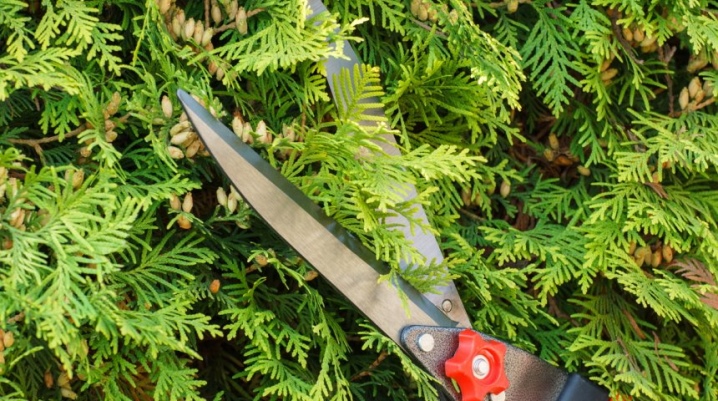
Reproduction methods
Thuja can be propagated in several ways:
- Seeds. This type of reproduction is rarely used, since it will take several years to grow thuja.
- Cutting is the most popular method. Reproduction by cuttings is usually carried out in the spring at a temperature of +17 degrees in this way:
- cuttings are cut from the stiff side branches;
- cuts of cuttings are treated with the growth-stimulating drug "Heteroauxin";
- prepare a nutrient substrate from perlite, vermiculite, peat and sand, taken in equal proportions;
- the cuttings are deepened into the mixture to a depth of about 3 cm;
- after planting, they need to be regularly sprayed with water. After the cuttings have roots, they are transplanted into open ground.
- Division of the bush. It is held in the spring after the snow melts, usually at the end of April. You can divide the bush if the root system of the plant is well developed and autonomous for each individual shoot. If the roots are poorly developed, they should be cut, and this can cause the death of the bush.
- Reproduction by horizontal layers. Layers are branches growing at the bottom of the bush and directed towards the soil. They are attached to the soil with wire and sprinkled. Rooting occurs only after a year, when young shoots grow on the layers. Then the layering is divided into new bushes and planted in the ground.
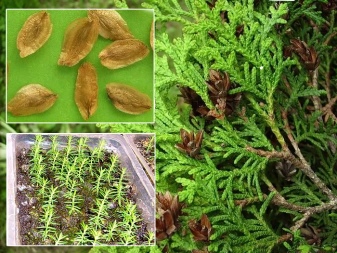
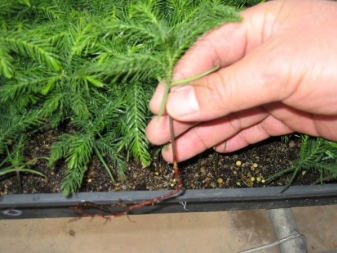
Diseases and pests
Thuja, like any plant, can develop diseases or harmful insects. Most often she has such problems.
- Excessive fertilization can result in root burns. As a result, the needles turn yellow. To avoid this, you need to strictly adhere to the norms when applying dressings.
- Excess moisture leads to phyto flora disease.First, the root system is affected, and then gradually the disease moves up to the crown. The needles turn gray, the stems are soft, and the bush itself withers. A putrid smell is felt near the bush. It is very difficult to treat phyto flora, it is easier to prevent it. To prevent it, you need to regularly loosen the soil and apply fungicides when watering. If the bush is damaged, it is better to dig up and burn, and change the soil.
- In addition to phyto flora, thuja can develop such a fungal disease as a mulberry mushroom, which affects the trunk, penetrating through the wounds in it. This leads to the death of the bush. For prophylaxis, it is required to spray the thuja with Bordeaux liquid. The branches with the mushroom should be removed.
- In early spring, the branches of the plant sometimes turn brown. Shoots die off without treatment. All brown branches that appear should be cut off, sprinkle with limestone around the bush and pollinate the crown with foundation.
Tuyu is most often affected by such pests.
- Thuvaya aphid. A sign of her defeat is the appearance of yellow needles. Aphids mainly affect the lower branches. For the destruction of pests, spraying with "Karbofos" is used.
- Speckled moth - small (about 4 mm), but very dangerous insect. Damage by moths leads to the death of the upper branches of the bush, while the needles become brown. For the prevention and control of moths, it is recommended to spray several times with insecticidal preparations. It is better to do this in the summer - at the end of June.
- Gray leaf rollwhich does harm by eating needles when it becomes a caterpillar. To combat it, use "Bitoxibacillin" and "Lepidocid" or chemicals "Ditox", "Fufanon".
- Click beetles harm the roots as they feed on them. In case of a disease, the soil is sprayed with "Fufanon", "Decis".
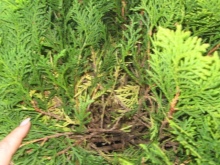
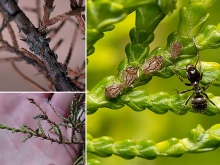

Use in landscape design
Spherical thuja is widely used in landscape design. Varietal variety allows it to be used in design compositions of any kind:
- in solitary plantings;
- in group plantings of the same variety;
- in mixed compositions using different varieties;
- as a hedge;
- for decoration of stone gardens (rockeries);
- in alpine slides of different sizes.
For single plantings and hedges, medium-sized and tall varieties are mainly used. Dwarf bushes are most often planted in alpine slides and rockeries, they can be grown in flowerpots and placed anywhere, for example, on a balcony.
Thuja looks good in combination with flowering plants and other conifers. It is used to decorate flower beds and flower beds, and decorate borders. Fluffy bushes go well with decorative elements such as sculptures, they look beautiful on a placer of stones.
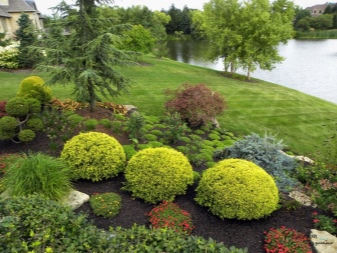
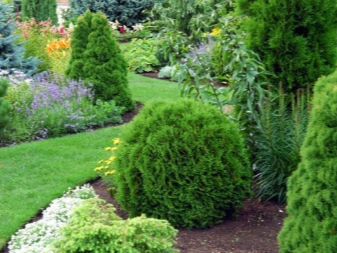
Tui, decoratively trimmed in the form of various shapes, create unique compositions and give any landscape a unique originality.
In the next video, you will see cropping of a spherical thuja.



































































The comment was sent successfully.